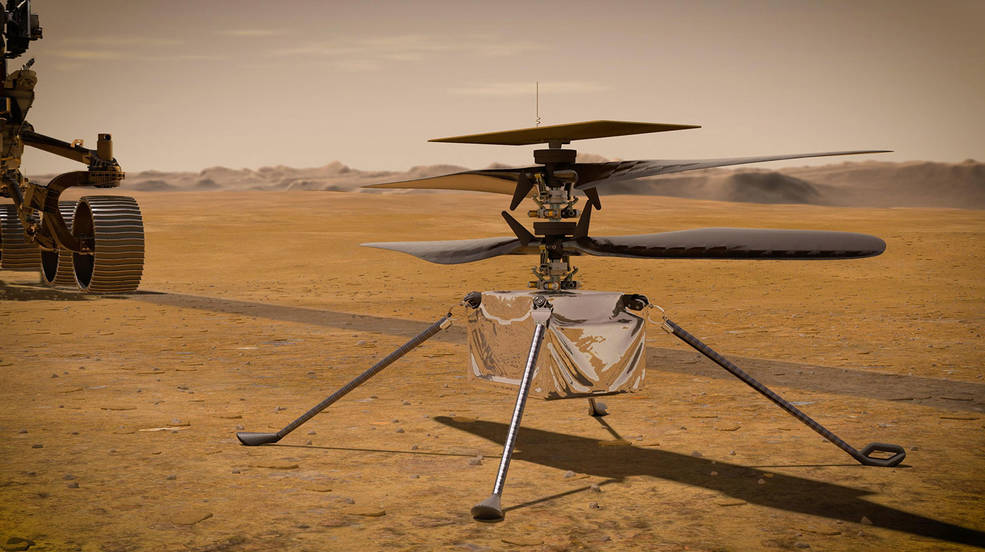US Space Agency NASA's special helicopter, Ingenuity, named by Vanija Rupani, an Indian-origin student, has sent first status report.
Ingenuity has been sent to Mars with Perseverance Rover to test whether rotorcraft technology can be used in Martian atmosphere. After the successful landing of the rover, the Ingenuity Helicopter attached to it has sent its first status report.
The National Aeronautics and Space Administration announced that the mission controllers at Jet Propulsion Laboratory in Southern California received the first status report from the Ingenuity, a 1.8 kilograms payload that landed at Jezero Crater of Mars attached to the rover’s belly.
In a statement the agency said that “The downlink, which arrived..via a connection through the Mars Reconnaissance Orbiter, indicates that both the helicopter…and its base station…are operating as expected.”
Ingenuity, the Mars Helicopter I carry, is working as expected. I’m currently charging it, but once I set it down, it’ll rely solely on its solar panels. If it survives the brutally cold Martian nights, the team will attempt flight. https://t.co/8pksN06ZwP #CountdownToMars pic.twitter.com/80kEoww0QU
— NASA's Perseverance Mars Rover (@NASAPersevere) February 20, 2021
What is Ingenuity Helicopter?
It might be called a helicopter, but in appearance its closer to mini-drones. Weighing just 1.8 kilograms, its blades are much larger and spin about five times faster than would be required to generate the same amount of lift back on Earth, because it doesn’t get assistance from Mars where gravity is only one third that on Earth.
Ingenuity has four feet, a box-like body, and four carbon–fibre blades arranged in two rotors spinning in opposite directions. It comes with two cameras, computers, and navigation sensors. Its also equipped with solar cells to recharge its batteries, much of the energy being used for staying warm in cold Martian nights, where temperatures fall to minus 130 degrees Fahrenheit (-90 degree Celsius).
Ingenuity will fly at altitudes of 3-5 meters and travel as far as 160 feet (50 meters) from its starting area and back. Each flight will last up to a minute and half.
Its onboard computers will work with its sensors and cameras to keep it on a path programmed by its engineers. But the outcome of these flights will be learned only after they took place.
The helicopter will be attached to the rover for 30-60 days. The electrical box in the rover will store and route the communication between the helicopter and the earth. It has been named the base station. Mission control on earth will ensure that the helicopters keep moving electronically in the very cold atmosphere of Mars. For this the heaters installed will be turned on and off. Its battery will also be charged so that the heater can run and other things can be done. The battery solar panel in the rover will be charged slowly at intervals of few days. Currently they are getting charged from the power supply of the rover. After launching it on the surface of Mars, the batteries will be charged with solar panels.
After landing from the rover, it will try its experimental flight for 30 days of Mars, after which it will try the first flight if it is safe in the cold nights of Mars. The night temperature on Mars can go up to about -90°C. According to NASA, the mission would be 90% successful if the helicopter managed to move a bit after taking off. If it continues to work after landing successfully, four more flights will be tested.
The surface of Mars is extremely bumpy, so rotorcraft is needed on Mars. For an orbiter rotating around Mars, only a limited range of height is clearly visible, at the same time it is very difficult for the rover to go to every corner of the surface, so there is a need for a rotorcraft that can fly to different difficult places and take high-definition pictures there.
Ingenuity Mars helicopter intends to test flight with limited capability for the first time. Unlike the Perseverance rover, the Ingenuity Mars helicopter is not carrying any science equipment onboard. Its purpose is to demonstrate rotorcraft flight in the extremely thin atmosphere of Mars.
On Friday, NASA released a number of stunning images of the surface of the Red Planet taken by the Perseverance rover. After it touched down near an ancient river delta in the early hours of Thursday, the rover will now search for traces of ancient life and will gather the most vital rock samples for a possible return to Earth.





















